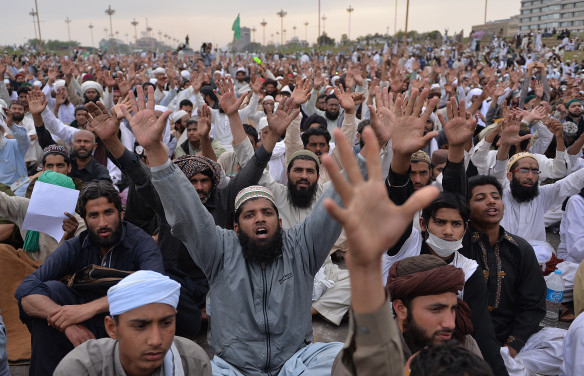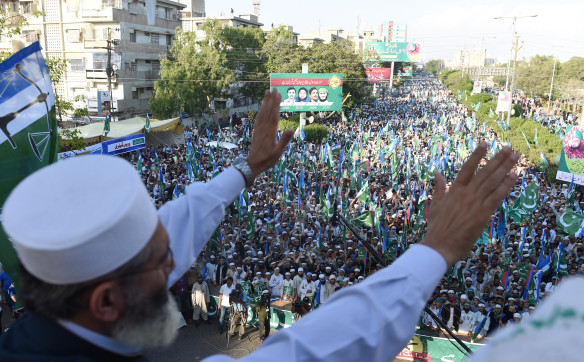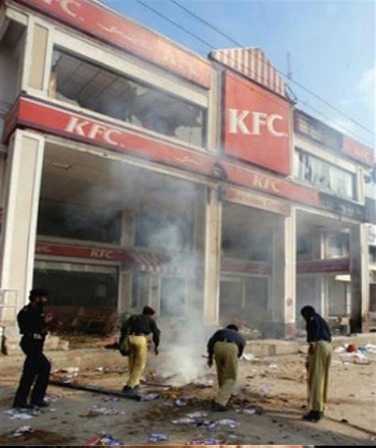Do or Die
By Ali Arqam | News & Politics | Published 9 years ago
When asked why they were marking the chehlum of Mumtaz Qadri after only 28 days, one of the protestors who have occupied Islamabad came up with a chilling response: He said it was being observed after 28 days because Qadri emptied 28 bullets into Salmaan Taseer. This is symbolic of the bloodlust of the protestors, led by the Sunni Tehreek, who went on a rampage in the capital, destroying Metro buses and breaching the Red Zone, before finally settling outside Parliament. An estimated 20,000 protestors were present in Islamabad, destroying property and even attacking journalists, out of which more than 2,000 still remain.
As the protestors rampaged through Islamabad, the government was nowhere to be seen. It took till 9 pm on the first day of the protests, only when Parliament was surrounded, for the army to be called in. Even then, the city administration tried to negotiate with them but they insisted on only dealing with the military. The next day, they said they would meet with a delegation of the National Assembly Speaker, the Senate President and a representative of the Punjab government. The protestors did issue a list of 10 bone-chilling demands, including the immediate execution of Aasiya Bibi, a memorial built for Mumtaz Qadri, the exile of all Ahmadis, no amendments to the blasphemy laws and the immediate execution of anyone accused of blasphemy.
The government has mostly been silent on events in Islamabad. Prime Minister Nawaz Sharif did briefly allude to it in his address to the nation when he said no one would be allowed to use religion to justify their lawlessness. The problem is that the government has allowed just that.
All of this is in stark contrast to the relatively muted reaction after the execution of Qadri.
Perhaps the more muted response after the execution was due to the secrecy in which it was carried out. The news of the execution before dawn on February 29 initially seemed like a canard. In the beginning, it seemed cable TV channels were reluctant to break the news, while the morning papers too carried no reports of the hanging. Only the Daily Jasarat — an organ of the Jamaat-e-Islami — reported the event, but it remains unclear whether the news was intentionally avoided by the mainstream media, or whether they got wind of it too late to put it in print. Likely, the directives to stay silent came from above since the news channels have largely shied away from covering the violence in Islamabad too.
When the Qadri hanging was confirmed, shopkeepers, traders and businessmen in Karachi were indecisive about whether to proceed with business as usual, or keep the shutters of their operations down as they feared a backlash from zealots of various religious-political parties and sectarian groups. Business centres and big markets in the city centre meanwhile, remained closed through the day, while small markets eventually opened, and public transport kept running although it had to often divert from its set routes due to partial roadblocks by protesters who assembled at various points like Shahrah-e-Faisal, Numaish Chowrangi, PIDC, Teen Talwar Chowrangi and Hub River road in Baldia Town. “Qadri was hung on Monday, and shopkeepers were reluctant to keep the shutters down after the Sunday holiday, but they were wary about what to expect from religious zealots, particularly in light of the muted response of the law-enforcement agencies in the past during such occasions. However, the situation was different this time,” said one shopkeeper in Saeedabad, Baldia Town.
He continued, “This time the police and Rangers were patrolling everywhere to ensure that any attempts at disruption of normal life would be made unsuccessful. This encouraged the traders, so many of them opened their shops for most of the day.”
It was indeed a welcome relief that despite protests by the “moral” brigade at multiple points and the assembly of large crowds on the day of the Qadri hanging, at his funeral the following day, and the gatherings engendered by protest calls the following Friday, the angry mobs did not manage to cause any major disruptions, torch vehicles, or vandalise private properties and shops.
That did not go down well with the self-appointed custodians of the faith who had wanted to make a major production of the execution. They then vented their anger at the press and electronic media for the insufficient coverage given to the protests and attacked members of the reporting staff and camera crews of assorted channels in Rawalpindi who were covering the post-Qadri funeral procession, and in Karachi and Hyderabad after Jumma prayers. Stones were also pelted at the office of Aaj News at Recorder House, Karachi, and a few vehicles standing there were damaged. The same day rioters attacked the Hyderabad Press Club. All this notwithstanding, the uproar was far less noisy and violent compared to similar protests in the past.
To compound the issue, the law-enforcement agencies were quick to lodge FIRs against the trouble-makers. An FIR was registered against 7,000 protesters at Numaish Chowrangi — including the leaders of various Sunni groups — for the violation of the Loudspeaker Act and attempts to incite hate against other groups. Another FIR was registered against 2,800 protesters in Baldia Town, including the local leadership of the Sunni Tehrik (ST). The name of Allama Abu Bakar Qadri, a scion of former ST leader, Saleem Qadri was among those featuring in the FIR, which included among other charges, violation of certain clauses of the Anti-Terrorism Act. In Islamabad, during the chehlum protests, though, while a few hundred people were detained, they were largely allowed to protest unimpeded.
The protests, both after the funeral and for the chehlum, were unarguably dominated by members of religious groups associated with the Barelvi school, perhaps the biggest sect in Pakistan.
 One of the violent groups associated with the Barelvi school, the ST, which recently changed its name to ‘Pakistan Sunni Tehrik’ (PST), was in the past guilty of employing all the tactics used by militant sectarian and political groups: intimidation, extortion and retaliatory violence against opponents. After Salmaan Taseer’s assassination, Qadri emerged as the poster boy for the Barelvi school. His portraits were an essential component at their congregations on Eid-e-Milad-un-Nabi. In fact, what was left of the Sunni Tehrik and all the other groups of the Barelvi school had pinned their hopes for a revival of fortune on Qadri, and started elevating his persona to that of a great Muslim warrior. And to further consolidate their strength they managed to bring all the like-minded groups from the Barelvi school under one banner — that of the Tanzeemat Ahle Sunnat (TAH). Now together, they began avowing that they would ensure a fate similar to Taseer’s for every alleged blasphemer. “Gustakh-e-Rasool ki eik saza, sar tan se juda, sar tan se juda.” (The only desired punishment for a blasphemer: severing his head from his body) became their rallying cry, heard at all their congregations. This was accompanied by eulogies on Qadri, laudatory speeches and poems about him, along with a robust defence of the blasphemy law.
One of the violent groups associated with the Barelvi school, the ST, which recently changed its name to ‘Pakistan Sunni Tehrik’ (PST), was in the past guilty of employing all the tactics used by militant sectarian and political groups: intimidation, extortion and retaliatory violence against opponents. After Salmaan Taseer’s assassination, Qadri emerged as the poster boy for the Barelvi school. His portraits were an essential component at their congregations on Eid-e-Milad-un-Nabi. In fact, what was left of the Sunni Tehrik and all the other groups of the Barelvi school had pinned their hopes for a revival of fortune on Qadri, and started elevating his persona to that of a great Muslim warrior. And to further consolidate their strength they managed to bring all the like-minded groups from the Barelvi school under one banner — that of the Tanzeemat Ahle Sunnat (TAH). Now together, they began avowing that they would ensure a fate similar to Taseer’s for every alleged blasphemer. “Gustakh-e-Rasool ki eik saza, sar tan se juda, sar tan se juda.” (The only desired punishment for a blasphemer: severing his head from his body) became their rallying cry, heard at all their congregations. This was accompanied by eulogies on Qadri, laudatory speeches and poems about him, along with a robust defence of the blasphemy law.
In November 2015, the TAH managed to draw huge crowds at the annual Eid-e-Milad procession and displayed their new flag comprising three stripes. The black and white stripe is borrowed from the colours of the tomb of Maulana Ahmed Raza Khan Barelvi, the founder of the Barelvi school in the 19th century, the blue stripe comes from the tomb of Sheikh Abdul Qadir Jillani, the 12th century saint and founder of the Qadri Sufi order, and the widest stripe, which makes up the major part of the flag, is the green portion from the tomb of the Holy Prophet (PBUH).
The circumstances of the past few years had created an atmosphere conducive to the sloganeering witnessed at TAH rallies. The visible reluctance by state institutions and political forces to carry out the sentence awarded to Qadri by the Anti-Terrorism Court (ATC) in 2011, given the fact that Qadri’s appeal in the High Court was not even taken up till January 2015, led to the impression that the state would not have the gumption to proceed against Qadri. During these years the abduction of Shahbaz Taseer, the son of slain Punjab governor Salmaan Taseer, and the news of the militants’ threats to kill Shahbaz if Qadri was executed, had further aggravated the situation.
 Additionally, in September 2012, following protest calls by religious parties against an insulting film by a Dutch director about the Holy Prophet (PBUH), violent mobs in Karachi, Peshawar and other parts of the country, went on the rampage, which resulted in 20 deaths and widespread loot and arson. This, like the Qadri execution aftermath, was one of the rare occasion when members of all sects and religious groups collectively organised protests.
Additionally, in September 2012, following protest calls by religious parties against an insulting film by a Dutch director about the Holy Prophet (PBUH), violent mobs in Karachi, Peshawar and other parts of the country, went on the rampage, which resulted in 20 deaths and widespread loot and arson. This, like the Qadri execution aftermath, was one of the rare occasion when members of all sects and religious groups collectively organised protests.
Against the backdrop of religious sentiment-sponsored violence, the government’s decision to implement the court verdict and execute Qadri was seen as a complete U-turn, welcomed by civil society, but deemed an act of betrayal by right-wing religious groups. The latter were particularly outraged since the ruling party, the Pakistan Muslim League (Nawaz) has usually maintained close links with the Punjab’s religious elements. In fact, just a few weeks prior to Qadri’s execution, video footage of Captain Safdar, PML-N lawmaker and son-in-law of Prime Minister Nawaz Sharif, was making the rounds on the internet, where he was shown speaking at a religious gathering and praising Qadri for killing a “blasphemer.” And the fact that many other PML-N members also had alleged ties with violent sectarian groups and would appease religious elements to get their support in the elections at the local levels was well known.
Owais Noorani, the head of his own faction of the Jamiat Ulema-i-Pakistan (JUP-N), terms Qadri’s execution as “judicial murder” and condemns the PML-N government for “appeasing” the West. Leaders of political parties like the Jamiat Ulema-e-Islam-Fazlur Rehman (JUI-F), and the Jamaat-e-Islami (JI) meanwhile, are linking Qadri’s sentence to a broader agenda: they say attempts are underfoot to turn Pakistan into a ‘liberal’ state by repealing laws like the Blasphemy Act and making new acts that are not in consonance with their obscurantist interpretation of Islam.
For its part, JUI-F, the Deobandi School’s political party, contributed very little to the protests against Qadri’s sentence, but it has instead taken a hard line against the recently approved Women’s Protection Act passed by the Punjab Assembly. On the other hand, the Jamaat-e-Islami yielded to rigid religious sentiment and organised a ‘Namoos-e-Risalat March’ in honour of the Prophet (PBUH) on March 13 in Karachi, with images of the “martyred” Qadri on billboards across the city, advertising the event. Interestingly, at the time of the Taseer assassination, the former Ameer of the Jamaat-e-Islami, Qazi Hussain Ahmed, had termed the murder as a sign of growing religious intolerance. “Taseer’s murder is extremely regrettable and condemnable. This shows the intolerance in our society,” said Qazi Hussain.
Diary of Zealotry
The response to the execution of Mumtaz Qadri followed the pattern of similar events in the past. During the last two decades, protests sparked by any incident viewed as ‘unIslamic’ by religious and sectarian groups usually resulted in havoc, with city streets under seige. Such protests resulted in the death of innocents, and losses to the tune of millions of rupees. Due to reluctance of the state machinery to interface with the mobs, they were free to set ablaze vehicles, ransack government and private buildings and vandalise places of business.
After the law-enforcement agencies’ seemingly new-found resolve to take action against political and religious violence, members of militant groups and sectarian outfits have recently been apprehended, or taken out in encounters. Resultantly, the ability of these groups to cause major disruptions and bring the city to a halt has considerably declined. And the Qadri execution was not the first time a more rational response was witnessed in the matter of religious intolerance. Even the Charlie Hebdo sketches last year had not engendered any really violent incident. But it was not too long ago when life could be brought to a standstill by rampaging mobs.
Some examples from the past…
A couple of years ago, an offensive film by a Dutch filmmaker had resulted in worldwide protests in the Muslim world, but in Pakistan the situation took a particularly ugly turn. The government announced a day of protest on September 21, 2012, and the day was named ‘Youm-e-Ishq-Rasool’ (The day of expressing love for the Prophet, PBUH). Cellular services were suspended and a public holiday was declared. But this was not deemed enough by the country’s religious groups and their protest calls across Pakistan led to angry mobs coming on the streets, setting six cinemas ablaze, looting banks and vandalising electronics shops. Four of six cinemas were burnt to ashes in Karachi and 27 people were killed.
OAugust 2, 2010, when MQM lawmaker Raza Haider was killed by the Waseem Baroodi group of Lashkar-e-Jhangvi (LeJ) militants, the three-day-long ensuing violence resulted in the death of more than 120 people. The MQM was quick to blame its opponents from the ANP for the killing.
On April 15, 2006, a blast at the annual Eid Milad-un-Nabi gathering organised by the religious parties of the Barelvi school resulted in the killing of 56 people, including the leadership of the Sunni Tehrik and members of various factions of the Jamiat Ulema-e-Pakistan. Protests following the incident resulted in roadblocks which hindered aid workers and ambulances from arriving at the site. Three vehicles were also torched in different parts of the city.
A suicide attack in the mosque of a Shia School in NIPA, Gulshan-e-Iqbal, Karachi, evinced a violent response. Mobs went into a frenzy, torching the franchise of the fast food chain, KFC. Four of the employees trapped in the restaurant premises were burned to death, while two others died after taking refuge in a refrigeration unit.
On May 30, 2004, a cleric associated with the Deobandi seminary of Binori Town was gunned down by unknown assailants. As a result, rioters from the seminary, joined by members of sectarian groups, torched 20 vehicles, two bank branches and one police station. Additionally, private and public property was set on fire and dozens of people were injured.
On May 18, 2001, Maulana Yusuf Ludhianvi, a cleric associated with Binori Town, was shot down in what is believed was a sectarian killing, and violent mobs comprising seminary students entered the offices of the Business Recorder, and set the office and the bank on the building’s ground floor ablaze. Cars, vans and motorcycles parked in the newspaper building’s compound were torched and badly damaged by angry protestors.
On May 18, 2000, Saleem Qadri, founder and chief of the Sunni Tehrik — a Barelvi hardline group — was killed in Baldia Town, Karachi, along with five others, by assailants from the rival Deobandi outfit, Sipah-e-Sahaba Pakistan (SSP). Riots erupted in Karachi as hundreds of angry Sunni Tehrik activists gathered and torched two police vehicles in Karachi’s Civil Hospital.
This article was originally published in Newsline’s April 2016 issue.
Ali Arqam main domain is Karachi: Its politics, security and law and order



